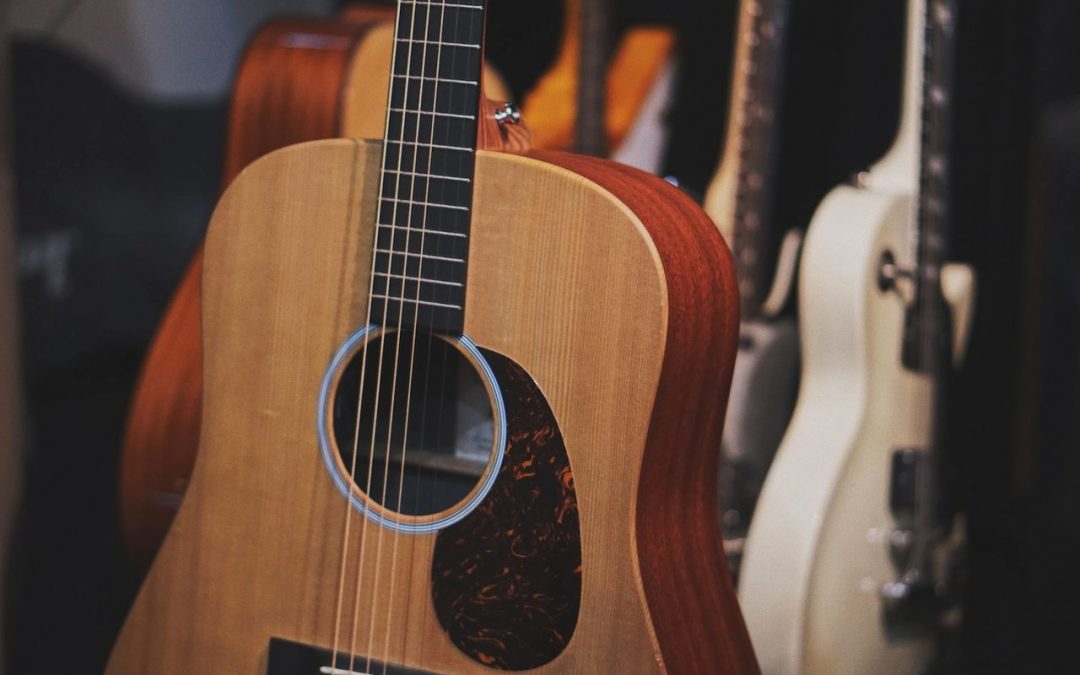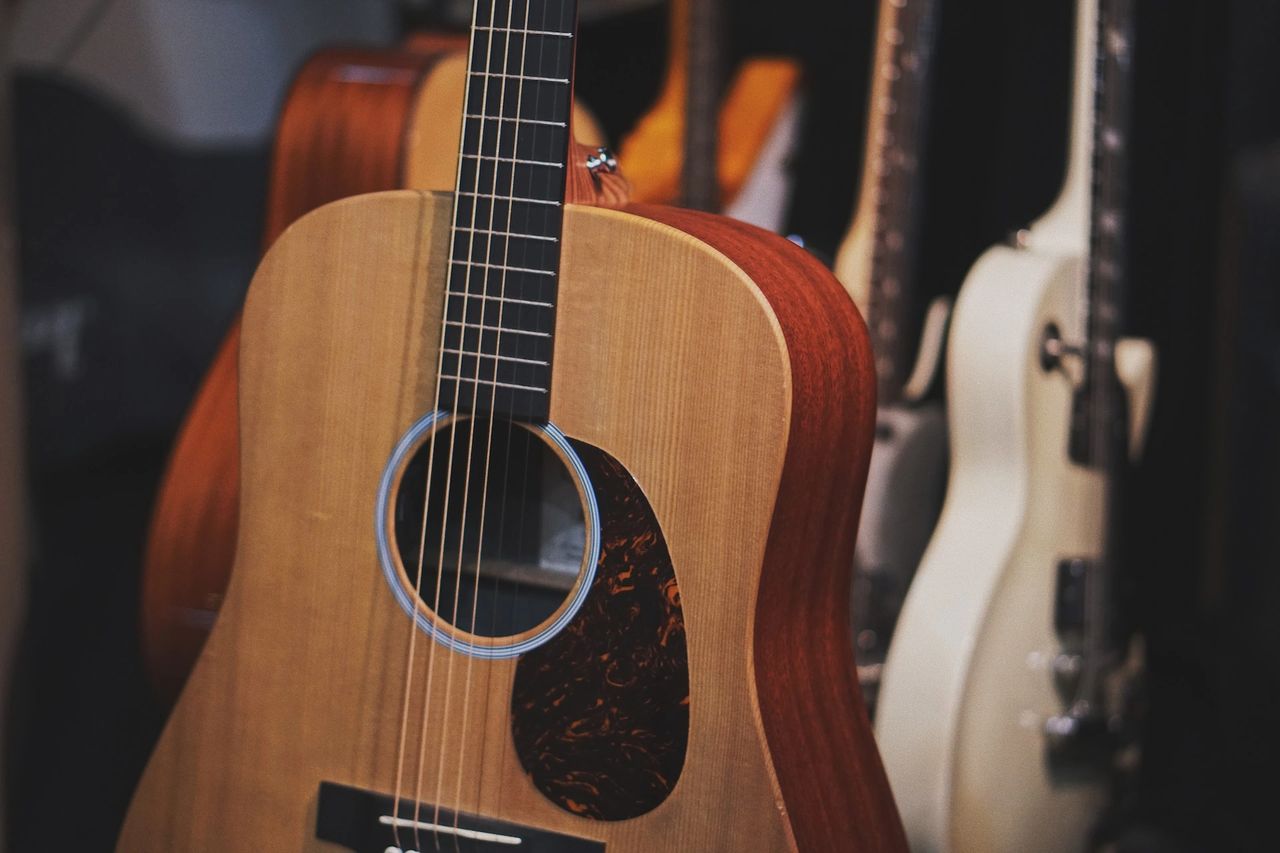
Finding the best-sounding acoustic guitar is a worthwhile journey if you love music and are ready to learn the craft. But it takes more than choosing something that looks impressive or is at the right price for your budget. You also need something that suits your personal preferences while considering what makes an acoustic guitar sound incredible.
This guide will take a look at what impacts an acoustic guitar’s sound, including its resonance or a bright, crisp tone. From body shape and tonewoods to playability and price, we’ll cover everything you need to know to find the right guitar for you.
What Makes an Acoustic Guitar Sound Good?
There’s no singular feature that makes an acoustic guitar sound good, but it all starts with tonewoods. Here’s a breakdown of what to look for in a guitar and how it impacts the sound you produce.
Tonewoods
Tonewoods, or the type of wood a brand uses, dramatically impact the sound quality of a guitar. Solid tonewoods are often preferred for their open, warm, and resonant sound. However, they’re also among the most expensive guitars you can buy.
Some brands rely on a blend of laminate and hard tonewoods to create a good sound without the sky-high price tag. The most well-regarded tonewoods are:
- Maple
- Sitka Spruce
- Ash
- American Basswood
- Rosewood
- Koa
There are a few things to remember when it comes to wood. Trees change throughout their lives, and their wood grain will evolve over time. You can find two guitars from the same brand made from the same type of wood but constructed a few years apart. The two guitars may sound noticeably different, and the location and season in which the tree was harvested could also impact how your guitar sounds.
Hardware
Just like tonewoods, the hardware also impacts the sound of an acoustic guitar. Generic hardware might sound okay, but the better the quality, the more sustainable a guitar usually sounds. Cheap laminate, tonewoods, and cracked hardware will only go so far when trying to scale your playing ability.
Strings

Strings make a significant impact on how well you can play guitar and the sound you produce. Strings don’t age well because most are made of metal and oxidize over time. The results are a strained vibration that doesn’t sound right when strumming through your favorite song. An old guitar sitting in your closet for a few years will likely sound dull and have several layers of dust collecting inside and out of it.
Here’s a look at how different strings sound based on their materials:
- Bronze – Articulate and bright
- Phosphor – Warm and rich
- Brass – Bright and metallic
- Wilk and steel – Gentle and mellow
- Nylon – Mellow, sweeping sound (commonly found on classical guitars)
The good news is that you can change out the strings on an old, but well-constructed guitar, and still produce a great sound. Beyond materials, the gauge of the strings also matters. The gauge is the thickness of the string, but even a few extra millimeters can significantly impact the sound. Lighter gauge strings are usually easier to play and produce a bright sound, while heavy strings usually project a more sustainable sound but often lead to finger pain or fatigue while playing.
Body Shape and Size
Guitar shape will also impact the tone of an acoustic guitar, including its resonance. Smaller guitars with little internal surface area usually produce a brighter and less resonant sound.
Hollow or semi-hollow guitars have louder, brassier tones. Beyond the construction and materials, a guitar body with high action on the neck is usually more challenging to play. As a result, a guitarist may not play as well, especially if they’re still learning their craft.
Playability
The guitar’s playability also impacts how it sounds, particularly when it comes to its action. The action is the height between the frets and the strings, ultimately changing how a guitar plays.
The higher the action, the greater the vibration, which some players love for its sustainable volume. However, lower action still sounds great and is typically easier to play, especially if you’re a beginner, have small hands, or are dealing with a condition like arthritis.
Electronics
Many acoustic guitars come outfitted with their own electronics package, with pickups built into the guitar. The bracing and space that electronics take up will impact the tone, making the guitar sound lower-quality when it’s not plugged in. Finding the right fit can take some trial and error, but typically the most reputable guitar brands are on top of their electronics and will put out a good product.
Neck Construction

Guitar necks can make or break your experience playing the guitar. The harder the wood on the neck, the brighter it sounds. Softer wood isn’t necessarily the wrong choice, but it does make a more mellow impression.
However, the size of the neck also matters in terms of how playable it is. The wider and thicker the neck, the harder it is to play if you have smaller hands, are new to guitar, or have a hand injury or arthritis. However, a thicker neck may work well for your needs if you have large hands or want a substantial grip.
Finish
The guitar’s finish can sometimes impact the tone, but it usually has more to do with how well it was applied. Some players notice that a heavier finish will dampen the vibrations of their guitar. It should be thin and spread evenly and flawlessly to protect the sound’s integrity. However, if you’re new to the acoustic guitar, you probably won’t notice much difference from the finish alone.
Craftsmanship
The best-sounding acoustic guitars come with high-quality craftsmanship and attention to detail. The higher the level of craftsmanship, the more expensive a guitar can be, but only to a point. A poorly made guitar that uses cheap tonewoods and subpar laminate won’t sound as good as one that’s been handcrafted with high-end materials.
The best-sounding acoustic guitars usually start at around $1,000 and go up. But when you start soaring into the $4,000 to $10,000 range, you’re largely paying for brand recognition. Just like when you buy a car, the biggest name brands aren’t always worth the expense.
For example, some Taylor and Martin Guitars soar into the $5,000 range. They sound great, but so do a lot of guitars at the $1,500 price point. Many of these premium guitar brands also sell a cheaper version of some of their most beloved models. Keep in mind that they primarily use less expensive tonewoods and often outsource production overseas to keep costs down. You’re missing out on locally made, handcrafted care at a reasonable price point that’s worth the investment in a great-sounding acoustic guitar.
Best Sounding Acoustic Guitars
If you’re ready to find some of the best-sounding guitars on the market, here are a few to choose from: We categorized our picks based on premium, affordable, and budget-friendly price points to help you make your choice.
Best Sounding Acoustic Guitar – Premium Price Pick: Martin D-45
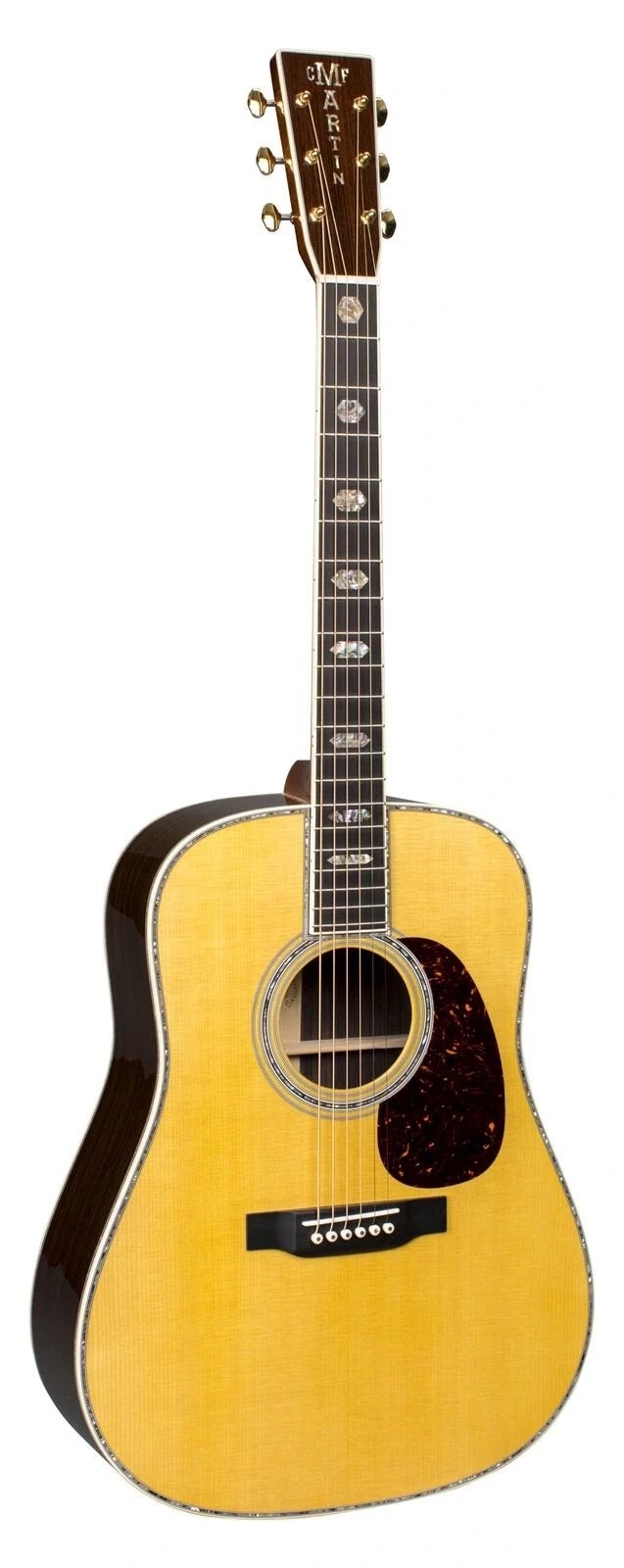
Initially designed for Gene Autrey, the updated Martin D-45 features a modern, modified, low-oval neck. As Martin’s flagship model, the D-45 is a top-of-the-line, dreadnought guitar with a Sitka spruce top and East Indian Rosewood back and sides. You’ll glide your fingers across a Mahogany neck and ebony fretboard. With a glossy finish, this guitar looks classy with gold-colored tuners and scalloped bracing.
- Price: $9,999
- Body Shape: Dreadnought
- Materials Used: Sitka, East Indian Rosewood, Mahogany, and Ebony
- Playability: Features a comfortable neck profile and a vintage sound with modern construction for improved playability.
- Tone: A full-bodied sound with a strong bass response, a balanced midrange, and shimmering treble notes.
- Pros: The Martin D-45 features exquisite craftsmanship and attention to detail, with touches like abalone inlays and mother-of-pearl bindings. You can play everything from folk to rock and blues on this model.
- Cons: You’ll pay a hefty price tag for the Martin D-45. Its finish is flawless, but could sustain damage if dropped or during travel. It’s also heavier than many players may like and simultaneously delicate.
Overall Winner: Best Sounding Acoustic Guitar – Mid-Range Price Pick: Zager ZAD900CE
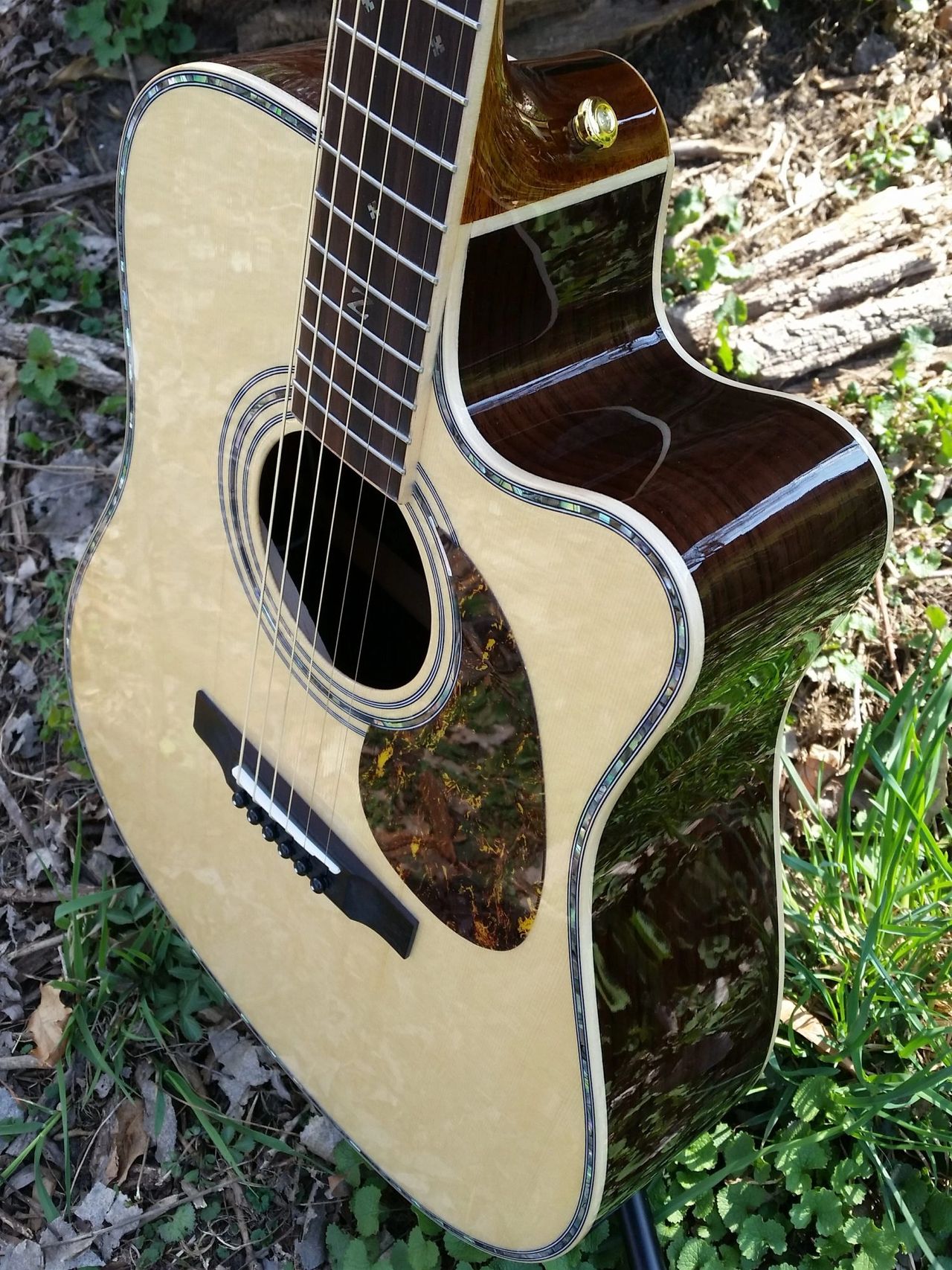
The Zager Guitars’ ZAD900CE easily competes with premium-level guitars like Martin’s D-45 but at a fraction of the cost. The brand was launched by Denny Zager of Zager and Evans who left their mark in 1969 with a chart-topping song that hit the Billboard Hot 100 in both the U.S. and the UK.
The ZAD900CE features a solid Sitka Spruce, Indian Rosewood, Maple binding, Abalone, and a Pearl inlay. Zager is known for hand-carved details, like its carved bracing for an even richer sound. With a slim neck and carbon-coated pillow-touch strings, the Zad900CE is more accessible to play than most guitars you’ll find.
You won’t find Zager Guitars in stores, but you’ll save by purchasing directly from the company and skipping the inflated retail prices. They also offer a free, two-way shipping policy, so you can try things out before making a commitment.
- Price: $2,395
- Body Shape and Size: Large, full-body dreadnought
- Materials Used: Sitka Spruce, Indian Rosewood, Maple, Abalone, and Pearl
- Playability: Zager is known for its easy playability, thin neck profile, and precision-perfect string placement to reduce hand fatigue.
- Tone: A warm and full-bodied sound that’s well-balanced
- Sound Quality: Holds a steady sound, and despite lowering the strings slightly for more comfortable playability, Zager masters their craft by getting the job done without any buzzing.
- Pros: Zager Guitars features a high-quality, balanced tone known for its ease of playing. With excellent customer service, players can inquire with the company about which guitars are best suited for them and enjoy a generous two-way shipping policy. The ZAD900CE price tag is an incredible value and is among the most premium brands out there.
- Cons: The Zad900CE’s tone is best suited for finger playing and not always ideal for large hands. Depending on your personal style, its natural finish may not align with your needs.
Best Sounding Acoustic Guitar – Budget Pick: Epiphone J200 EC Studio
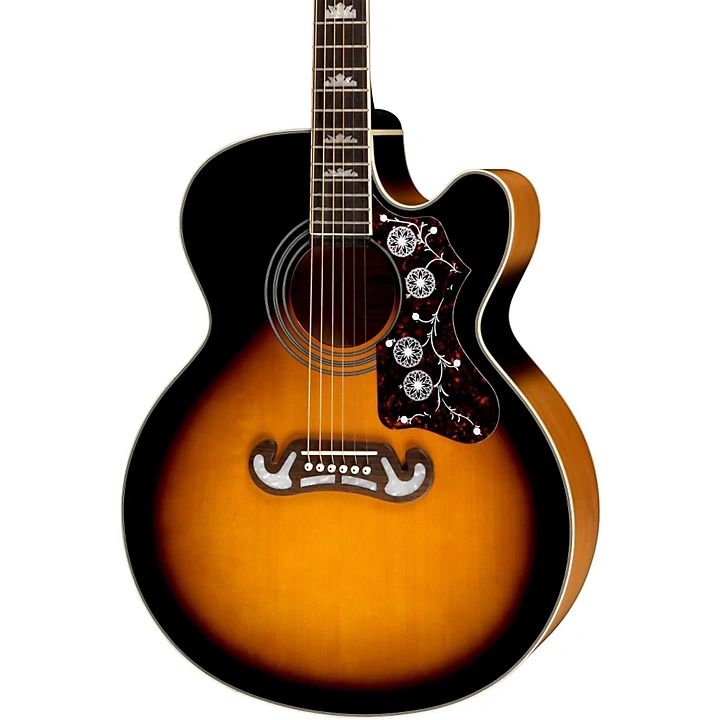
Dubbed “the king of flat tops,” the Epiphone J200 EC Studio gives a nod to the classic Gibson SJ-200 but at a fraction of the price tag. With a Super Jumbo body and maple neck, this guitar features an under-saddle pickup and preamps built directly into the tuner. It’s a good option for serious players on a budget looking for decent quality and craftsmanship. It’s also great for studio playing with its built-in Fishman Sonitone pickup system to enhance amplification.
- Price: $469
- Body Shape and Size: Super jumbo body with a cutaway
- Materials Used: Maple and solid Spruce
- Playability: The Epiphone J200 EC Studio features a comfortable, rounded, and slim tapered C profile that feels good to play and a low action for fluid playing.
- Tone: Expect a warm, balanced, big, bold tone ideal for strumming and fingerpicking.
- Sound Quality: With a crisp, clear tone, this Epiphone holds its sound across multiple genres for a balanced tone with plenty of clarity and projection. The built-in electronics and pickup system allow for easy amplification.
- Pros: The comfortable, slim neck profile makes it easy to play for a balanced tone that resonates clearly. It’s also a budget-friendly alternative to more expensive Gibson guitars on the market.
- Cons: Despite the lower price tag, this Epiphone is still expensive compared to other budget-friendly options. Some players have also reported issues with the finish and its potential to scratch.
Final Thoughts
Finding the best-sounding acoustic guitar isn’t that challenging when you consider what makes it play great and the kind of tone it holds. It also comes down to personal preference and the kind of sound you prefer. You may want a bright, resonant tone, and someone else may prefer something mellow and softer.
Although quality tonewoods and strings are essential to a great-sounding acoustic, they’re not the only areas to consider when making your next guitar purchase. Make sure playing is easy and comfortable, making you sound better at your next gig.
